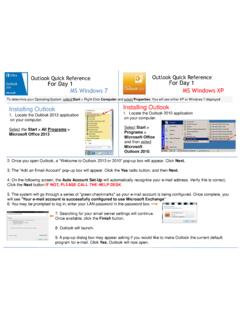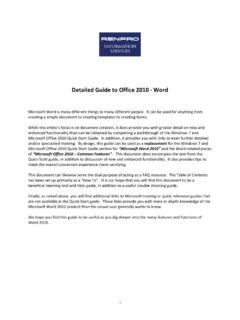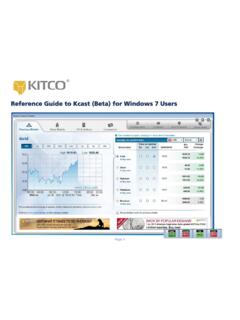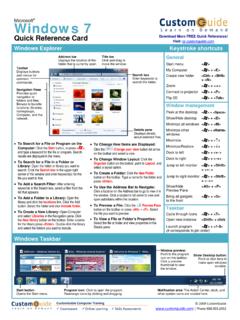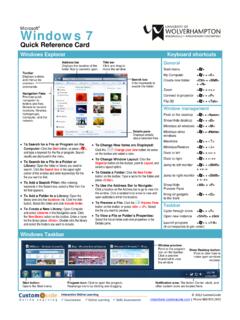Transcription of ColourManager - Change Colours - it.ucsf.edu
1 quick ReferenceMicrosoft windows 7 2013 Digital Content Factory Ltd. for UCSF Medical Center. Microsoft and windows are registered trademarks of Microsoft windows 7 InterfaceDesktop A general working area of the windows 7 operating system where you can put programs and documents, or their shortcuts, for quick access. The initial Desktop includes the Desktop background, Recycle Bin, and Taskbar (which by default contains the Start button, pinned program icons, and the Notification area).Start Menu Displays icons and menu items that may be used to start programs and/or open documents, including commands for accessing Help and pausing or ending your current windows windows Display the contents of drives or folders as icons or lists of files and subfolders. You can use a window's Navigation pane or Address bar to quickly navigate to other Customizable mini-programs designed to display continuously updated information without opening a window ( , weather forecasts, news headlines, or photo slide shows).
2 Taskbar buttons Represent open windows and may be used to switch from one program or document to another. Pointing to a button displays an indicator, which may be in the form of a screen tip as shown above, or if the computer supports the Areo Desktop, a live preview of the application/document will windows Display the contents of documents that are open in the currently running Bin Temporarily stores files that you delete from your hard disk (until you empty the Recycle Bin) so that you can recover accidentally deleted items by restoring them from the Recycle Bin. Note that items deleted from removable disks are permanently deleted, not stored in the Recycle Bin; you will be warned Icons Provides direct access to starting programs, or opening documents. The examples shown above start Internet Explorer, windows Explorer, and windows Media Area Displays status indicators for system and program-related features, as well as the date and Bar An Explorer window s toolbar, which contains buttons relevant to the current situation.
3 For example, when you open the Network window, the Network and Sharing Center button appears Bar May appear below the Command Bar to display tips about how to proceed in the current situation. Some tips may prompt you to click the Information Bar itself in order to Contains the Start button, pinned icons, toolbars (optional and not shown), taskbar buttons, and a notification button Used to open the Start Menu, from which you can select an item to start or open. In the example shown below, the windows Help and Support facility has been started. See Getting Help on page 2 for steps on how to use it. Microsoft windows 7 is a computer operating system, primarily used with personal computers (PCs), such as desktop computers, laptops, netbooks, and tablets. Its purpose is to interface between the user and a computer s hardware, which is responsible for managing activities and system resources.
4 A computer s operating system is critical because it cannot operate without one. That is why computers are normally purchased with an operating system preloaded. This windows 7 operating system contains enhancements to the user interface and the management of on-screen windows , as well as the functionality to share data on a home network, manage computer usage, and improve performance and compatibility with newer hardware and software Objectives PAGE 1 Microsoft windows 7 Interface Learn about some of the enhancements to Microsoft windows 7 and the updated user 2 Getting Started Learn how to start and exit windows 7, as well as start programs, manage windows , and access Files and Folders Learn how to navigation the Explorer window and perform file management 3 Finding Folders and Files Learn how to effectively locate folders and with Network DrivesLearn how to access network drives to share Documents Learn how to print.
5 Open and manage the print 4 Customizing windows 7 Learn how to Change settings to accommodate your personal 2013 Digital Content Factory Ltd. for UCSF Medical Center. Microsoft and windows are registered trademarks of Microsoft windows 7 quick reference `Starting and Ending windows 7 your c omputer the user name associated with the account to which you wish to log in. OR If the user name you wish to use is not listed, click Other User and type the user : If your computer is part of a domain, and you wish to l og on to a local user account, you must type the name of your computer, followed by a backslash (\), prior to the user name. For example: computer name\user name. To obtain the computer name, click the Start button, right-click Computer, and then select the password, and press ENTER. To end your windows session, click the Start button, and then click Shut down.
6 Click the button to access other options that are available depending on system configuration: Switch User switches users without closing programs. Log Off closes programs and logs off. Lock suspends the use of the computer with password protection (the user s or administrator s password.) Restart closes programs, shuts down windows , then starts windows again. Sleep keeps the session in memory and puts the computer in a low-power state to allow you to quickly resume working. Hibernate saves the session to disk and turns off the computer to allow you to resume working where you left off.`Starting the Start button and select the desired program the program icon is not located directly in the Start Menu, point to the required group to locate the desired program icon and click it. OR Click the Start button and begin typing the name of the program in the Search box until the desired program appears in the results list.
7 Then click the desired program.`Arranging an empty area of the Taskbar (next to the Start button if the Taskbar is full) and select the desired arrangement. Cascade windows overlaps open windows starting at the top-left corner of the screen, with each window the same size. Show windows stacked resizes and arranges open windows to fill the screen, with each window as wide as possible without overlapping or being too narrow. Show windows side by side resizes and arranges open windows to fill the screen, with each window as tall as possible without overlapping or being too narrow. Show the desktop minimizes open : Once one of the above has been selected, the Undo command becomes available to return the windows to the previous arrangement. OR To compare two windows only side by side using the Snap feature, drag the title bar of one of the windows to one side of the screen until you see an outline appear that indicates the window shape, and release the mouse button.
8 Repeat this step with the other window, on the opposite side of the screen.`Switching windows Using the down the ALT key and press TAB repeatedly to cycle through a list of open windows . Release the ALT key to switch to the highlighted window. OR Press ALT+ESC to activate the next window. If the window is currently minimized, press ENTER to restore it.`Opening Documents Using Jump the Start button, and then point to the icon of the program that was used to create the document to be the name of the document to be opened. OR the icon of the program used to create the document to be opened from the : This step will work if the application is open, or if the application has been pinned to the the name of the document to be opened. To pin an item to a Jump List, point to the desired item, and then click the Pin to this list icon.
9 To unpin an item from a Jump List, point to the desired item, and then click the Unpin from this list icon.`Getting Start>Help and Support. OR Press a word or phrase describing the desired topic in the Search Help box and press ENTER. OR Click the Browse Help button, then click a desired item in the subject heading list.`Folders and Libraries OverviewComputer data is stored and organized in folders on a computer drive(s). windows 7 also includes Libraries, which are virtual locations where the files from multiple folders may be displayed together in one place. For example, the Pictures library may be used to display picture and image files from different folders on the drive. Specifically, the My Pictures folder and the Public Pictures folder are included by default in the Pictures library, but other folders can be added as desired.
10 `Opening Explorer the Start the desired folder or library from the list below: Name (where name is the user name logged in) to open the personal folder for that user. Documents to open the Document library from which Word, Excel, PowerPoint, and other documents may be displayed. The My Documents folder and the Public Documents folder are included by default. Pictures to open the Pictures library from which various picture and image files may be displayed. Music to open the Music library from which various music and audio files may be displayed. The My Music folder and the Public Music folder are included by : Other libraries may be available. Computer to display the hard disk drives, and removable storage devices required, to display the contents of a subfolder or a disk drive listed in an Explorer Window, double-click its name or icon.



